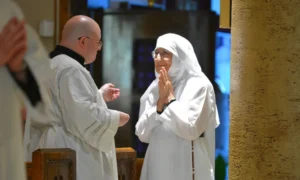 For two years, Victoria Carver attended the IRL’s National Meeting as a lay woman. As of October 16, 2025, the Feast of St. Margaret Mary Alacoque, she is officially the first Diocesan Hermit in the Diocese of Des Moines in Iowa. Now known as Sr. Teresa Charbel, Er.D., she was consecrated at the Basilica of St. John by her bishop, Most Rev. William Joensen.
For two years, Victoria Carver attended the IRL’s National Meeting as a lay woman. As of October 16, 2025, the Feast of St. Margaret Mary Alacoque, she is officially the first Diocesan Hermit in the Diocese of Des Moines in Iowa. Now known as Sr. Teresa Charbel, Er.D., she was consecrated at the Basilica of St. John by her bishop, Most Rev. William Joensen.
The following are excerpts of her story as written on the Diocese of Des Moines website:
She’s taken a circuitous path to consecrated life. At age 79, she’s a mother of four, grandma to 11 and great-grandma to five. She was divorced in 1980, and her marriage was annulled by the Church in 1984. She’s a recovering alcoholic who converted to Catholicism in 2000.
“Recovery is rooted in regular prayer and other daily practices that build virtue and foster humility,” she said. “As I surrendered to God in desperation and continued in faith, His power enabled me to do what I could not, and I began to experience miracles in my life.”
Intense and committed intercessory prayer, when one of her children faced a health crisis, led her deeper into prayer, as she called on St. Teresa of Avila and St. Teresa of Kolkata (also known as Mother Teresa) for heavenly help.
“People began asking me to pray for their intentions, and my heart got bigger, growing in charity, as I prayed for others,” she said. Involvement in a lay religious movement led her to a spiritual director, daily adoration, and praying the Liturgy of the Hours. She committed her life to the Lord on retreat and thought she was called to found a women’s religious order in the Diocese of Des Moines.
“Many desire to see women’s religious life flourish here again, as it once did. Our diocesan priests and parishes need it. Families and young women need it,” she said.
“Though Bishop (Richard) Pates agreed and, in 2015, supported the concept I proposed, my efforts bore little fruit. …I’ve had to learn the hard way that God doesn’t lead me by giving me the end point. If he did, I would plan my route to get there,” she said, “and I’m not a very good planner. Instead, he just leads me to the next stop. I needed to learn to follow him and his shepherds with docility and trust.”
She met regularly with priests and her spiritual director who advised her on canon law, church history, and others who could help her to discern. Eventually her spiritual director recommended that she inquire with her bishop about becoming a diocesan hermit.
 “The next year, I met with newly installed Bishop Joensen, who was open to exploring my request for eremitic consecration, helping close the door on founding a new order.”
“The next year, I met with newly installed Bishop Joensen, who was open to exploring my request for eremitic consecration, helping close the door on founding a new order.”
For the next few years, Sister Teresa received rigorous formation through much solitary prayer in adoration and study.
When it came time to write a Plan of Life to present to Bishop Joensen — which she didn’t know how to do — two diocesan hermits from a Nazareth Hermitage, in Ava, Missouri, sought overnight accommodations in Des Moines. …. These were the first hermits she had ever met in person.
“Sister Maria Dara affirmed my eremitic vocation, taught me to write a Plan of Life, and I presented it to Father (PJ) McManus. Bishop Joensen read it, consulted Father and other priests, and asked me to live with some experienced hermits in formation for at least four months. One hermitage was vacant at the Nazareth Hermitage compound and I was enthusiastically welcomed there.. . . which ultimately led to my consecration this month.”
During her consecration, Sister Teresa made vows of poverty, chastity, and obedience to the Bishop. After her name will be the letters ER.D., for “erimetic,” a descriptor of a hermit and “diocesan.” She wears a white habit that stretches from her hair down to her feet.
Pope Leo XIV said that “to be a hermit, he said, “is not an escape from the world, but a regeneration of the heart, so that it may be capable of listening, a source of the creative and fruitful action of the charity that God inspires in us.”
To read the full article, visit the Diocese of Des Moines website.
From the Code of Canon Law, here is a description of the life of a hermit or anchorite:
Canon 603. §1 Besides institutes of consecrated life, the Church recognizes the life of hermits or anchorites, in which Christ’s faithful withdraw further from the world and devote their lives to the praise of God and the salvation of the world through the silence of solitude and through constant prayer and penance.
§2 Hermits are recognized by law as dedicated to God in consecrated life if, in the hands of the diocesan Bishop, they publicly profess, by a vow or some other sacred bond, the three evangelical counsels, and then lead their particular form of life under the guidance of the diocesan Bishop .